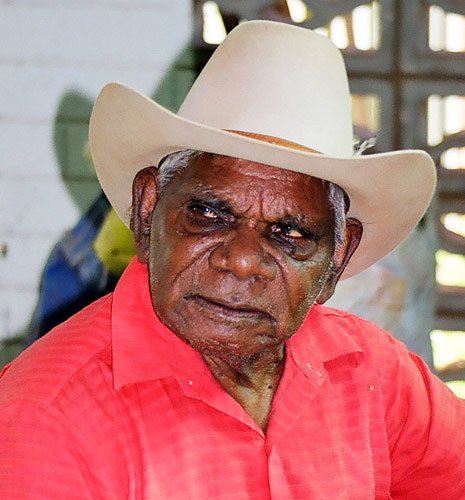BILLY JOONGARRA THOMAS
BIOGRAPHY

Billy Joongarra Thomas (c.1920 – 2012) began painting for Waringarri Arts in Kununurra in 1995. He was already in his seventies and like his friend and fellow artist Rover Thomas had spent his youthful years droving cattle on the Canning Stock Route, deep in the remote desert regions of Western Australia. He knew his country intimately and never ceased his ceremonial immersion and involvement within it. Right up until his final years, he continued to spend long periods ‘out bush’ before coming in to Billiluna or Kununurra again to paint. He was revered as a senior lawman and healer, custodian of secret initiation rites and ceremonial songlines. By the time he died in his 90s, peacefully, in the aged care facility at Fitzroy Crossing, he had participated in major exhibitions that brought the Kimberley tradition and history to the world. His paintings are held in state and private collections worldwide, still commanding high prices as part of a treasured and important indigenous legacy.
Born near Billiluna, the southern end of the Canning Stock Route, Billy inevitably became caught up in the repercussions of this huge well-sinking and cattle-moving project through the Great Sandy and Gibson deserts, which was nearing completion at his birth. The traditional nomadic lifestyle of his Wangkajunga people, like all the desert tribes of this vast inland area, was disrupted and their sensitive ecological balance with their ancient homelands destroyed forever. Alongside other young Aboriginal men, Billy began droving cattle through the northern regions and tapping into a great cultural interchange that in some respects was the only positive aspect of what became known as the ‘wild time’. As later histories have laid bare, brutal treatment from white settlers saw the widespread killing, dislocation and dispossession of the desert dwellers. During this time, their traditional network of ceremonial songlines and shared sacred sites became a source of social interchange and spiritual support, directly feeding into the evolution of today’s vital Kimberley art movement.
From the mid 1980s, contemporary artworks from the Kimberley were shown in Australia’s state galleries to an appreciative public audience, and recognisable personal styles emerged. The decade ended with the first Aboriginal artists (Rover Thomas and urban artist Trevor Nickolls) to represent Australia at the Venice Biennale. Some time later, around 1995, Billy Thomas walked into Waringarri Arts to ask the manager, Kevin Kelly, for art materials and was soon rewarded with sell out shows himself. His unique, gritty ochres, with their palpable sense of earthy authenticity, employed traditional desert iconography to depict country through the lens of its ancestral associations. His cultural knowledge was formidable, but he would dot over and scrape back his mark making in order to ensure that secret, sacred aspects were veiled from general view. This gave a distinctive lightness to his work, reflected in his colour choices of much white and light grey, dusky pinks and yellow-brown ochres.
Billy’s totem was the black snake . Its sinewy swirls thread through his own Dreamtime landscapes, connecting the underground waterholes that are the vital sites of replenishment and ceremony. Waarla is a huge mudflat in the Great Sandy Desert that becomes a vast lake after rain. It is a historic meeting place for diverse desert rites that Billy maintained and taught to young initiates. His connection to the land was inextricably woven into his art. Billy’s fluidity of drawing became more accentuated in his later works. Gestural brushstrokes carry sumptuous white across the daubed and layered surface - the earthy being supplanted by the atmospheric. Billy stopped painting in 2005 but not before tutoring his son, Lloyd Quilla. His seminal works are likley to provide foundational patterns for a future generation of artists.
Author: Sophie Pierce
References
Ryan, Judith (editor), Colour Power - Aboriginal Art Post 1984, National Gallery of Victoria, Melbourne, 2004 (C).

